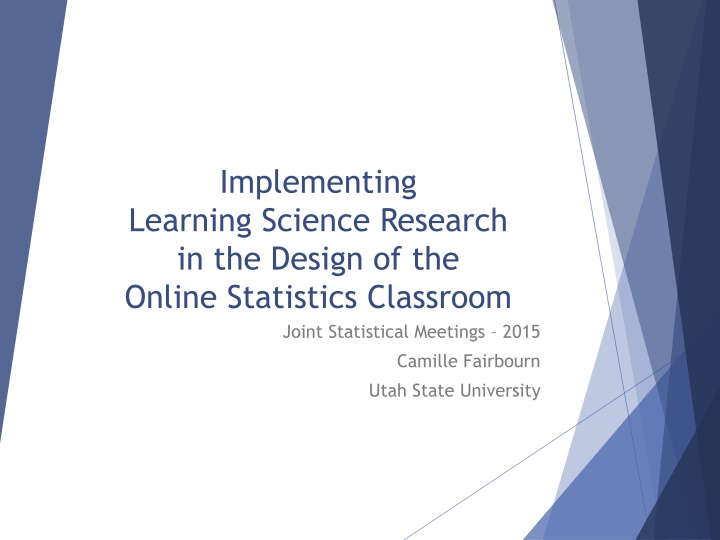
Implementing Learning Science Research in Online Statistics Classroom Design
Explore the integration of learning science research in designing an effective online statistics classroom. Learn about the transition from traditional to online learning environments, teachers as curriculum designers, and the importance of setting clear objectives in education.
Download Presentation

Please find below an Image/Link to download the presentation.
The content on the website is provided AS IS for your information and personal use only. It may not be sold, licensed, or shared on other websites without obtaining consent from the author. If you encounter any issues during the download, it is possible that the publisher has removed the file from their server.
You are allowed to download the files provided on this website for personal or commercial use, subject to the condition that they are used lawfully. All files are the property of their respective owners.
The content on the website is provided AS IS for your information and personal use only. It may not be sold, licensed, or shared on other websites without obtaining consent from the author.
E N D
Presentation Transcript
Implementing Learning Science Research in the Design of the Online Statistics Classroom Joint Statistical Meetings 2015 Camille Fairbourn Utah State University
If you dont know where you re going, how do you know when you get there?
How I came to Love Learning Objectives
From Traditional Classroom To Online Classroom
From Online Classroom To Traditional Classroom
Teachers are designers. An essential act of our profession is the crafting of curriculum and learning experiences to meet specified purposes. We are also designers of assessments to diagnose student needs to guide our teaching and to enable us, our students, and others (parents and administrators) to determine whether we have achieved our goals. Grant Wiggins and Jay McTighe in Understanding by Design, Chapter 1
Teachers are designers. An essential act of our profession is the crafting of curriculum and learning experiences to meet specified purposes. We are also designers of assessments to diagnose student needs to guide our teaching and to enable us, our students, and others (parents and administrators) to determine whether we have achieved our goals. Grant Wiggins and Jay McTighe in Understanding by Design, Chapter 1
Understanding by Design 1. Identify desired results. 2. Determine acceptable evidence. 3. Plan learning experiences and instruction. Grant Wiggins and Jay McTighe
Introduction to Statistics Course Objectives The purpose of this class is 1. To give you experience with statistical processes in personal and professional spheres, including where they are used, how they are used, the advantages they provide, and their limitations. 2. To provide you with a foundation for future Statistics courses.
Histograms and measures of center Syllabus Topic New Objective Descriptive statistics: the histogram, the density scale, the average and the SD and their relationship to the histogram, Given a histogram, students will visually estimate the average, standard deviation, and median of the data.
Confidence Intervals Syllabus Topic New Objective confidence intervals and their interpretation Given sample statistics, students will calculate a confidence interval for the average at a given confidence level. interpret a confidence interval.
Assessment Question A candy company is market-testing a new brand of chocolate bar. A simple random sample of 400 people were given the new chocolate bar to try. A total of 285 said they liked the candy. Choose from the answers below the interval that is closest to a 98% confidence interval for the population percentage of people who will like the new chocolate bar. 71.3% to 98.0% 66.0% to 76.5% 67.5% to 75.0% 70.0% to 76.6%
Assessment Question Marketing executives at a dairy company gave a new flavor of yogurt to a focus group of 385 randomly selected people. Based on the number of people who said they liked it, they calculated a 90% confidence interval for the true percentage of customers who will like the yogurt to be 35.8% to 44.1%. Choose the statement that is TRUE. The company can reasonably believe that at least 50% of consumers who try the new yogurt will like it. About 90% of people will say they like the new yogurt between 35.8% and 44.1% of the time. The company can be 90% confident that the true percentage of consumers who will like their new yogurt is between 35.8% and 44.1%. There is a 90% chance that the sample percentage of people who will say they like the new yogurt will be between 35.8% and 44.1% if we take another simple random sample of 385 people.
Benefits Clarity Confidence Observable, quantifiable results
Contact Information Camille Fairbourn Utah State University Brigham City Regional Campus Camille.Fairbourn@usu.edu http://www.math.usu.edu/cfairbourn
